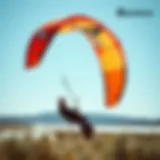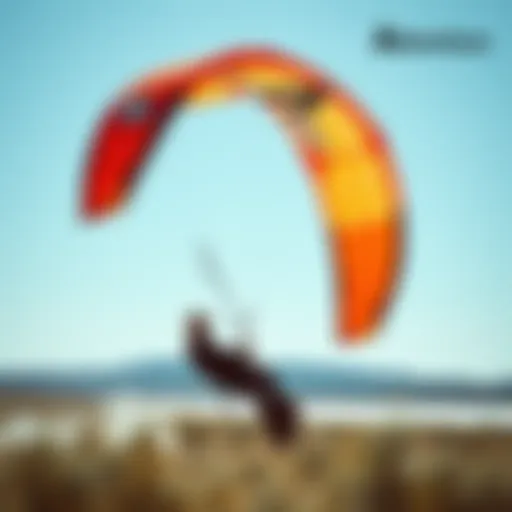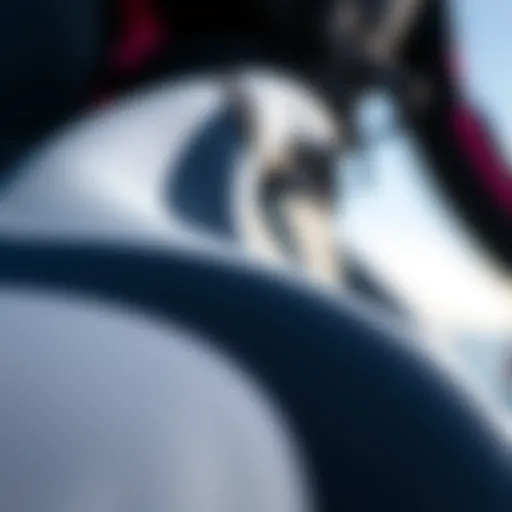Exploring Kite Sails: Key to Mastering Kiteboarding
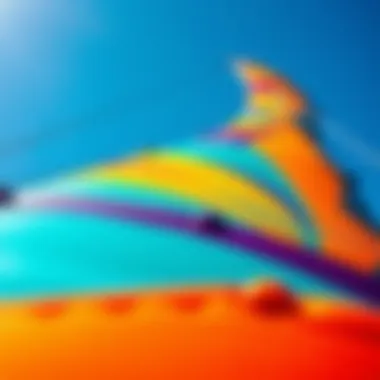

Intro
Kiteboarding is a thrilling sport that combines the adrenaline rush of surfing and wind-powered sailing. At the center of this dynamic experience are kite sails, the essential equipment that connects riders to nature's powerful breezes. The intricacies of these sails, from their design to their materials, play a pivotal role in defining the kiteboarding experience. For beginners and seasoned kiteboarders alike, understanding the fundamentals of kite sails can enhance performance, safety, and enjoyment on the water.
In this article, we'll take an in-depth look at the world of kite sails, discussing their various aspects, including gear selection and skill development. With the right knowledge, anyone can become a more informed and competent kiteboarder, ready to tackle the waves with confidence.
Gear Selection
Types of Kites
The kite you choose to use forms the backbone of your kiteboarding journey. There are several types of kites, each designed for specific conditions and riding styles. Here, we break down the most common types:
- Foil Kites: These kites are renowned for their efficiency and performance. They are lightweight and can perform well in low winds, making them suitable for beginners.
- LEI Kites (Leading Edge Inflatable): Characterized by their inflated leading edges, LEIs provide excellent stability and easy relaunching from the water. They are often favored by freeride and freestyle kiteboarders.
- Hybrid Kites: These kites blend features of both foil and LEI kites, aiming to offer versatility for various conditions. They are a great option for those who want flexibility in their kiteboarding adventures.
Selecting the right kite size is equally crucial. A larger kite catches more wind and is ideal for lower wind conditions, while a smaller kite responds better in strong winds.
Choosing the Right Board
Just as vital as your kite is the board you ride on. The board's size, shape, and construction affect your riding experience intimately. Here are key factors to consider:
- Board Size: Generally, larger boards offer more stability and are beneficial for beginners or light wind conditions. Smaller boards provide quicker responsiveness and higher speeds.
- Board Shape: Directional boards are suited for surfing-style riding, while twin-tips allow for versatility in both directions, making them popular among freestyle riders.
- Construction Materials: Most boards are constructed from foam cores with varied materials for durability. Choosing a board made from lighter materials can enhance your overall performance on the water.
Skill Development
Essential Techniques
With the right gear selected, it's time to focus on skill development. Mastering fundamental techniques will lead to a more enjoyable and safe kiteboarding experience. Some essential skills include:
- Kite Control: Understanding how to pilot your kite effectively is paramount. Start with simple drags using the kite around the water to get accustomed to its power.
- Water Starts: Once comfortable with kite control, practice standing up on your board while maintaining balance. Water starts require timing and coordination, so patience is key.
- Riding Upwind: This technique involves using the kite's pull to maneuver against the wind. It’s crucial for returning to a launch site after a session.
Progression Tips
Improvement in kiteboarding doesn’t happen overnight. Here are some tips to help you progress:
- Set Goals: Establish realistic goals for your sessions. Whether it’s mastering a new trick or refining your technique, having a benchmark helps you stay focused.
- Practice Regularly: Consistency is vital for progress. The more time you spend on the water, the more proficient you will become.
- Seek Feedback: Don't hesitate to ask for advice from more experienced riders or instructors. Fresh perspectives can provide insights that you might miss on your own.
"The kite's design, choice of board, and rider's proficiency all come together to create the ultimate kiteboarding experience. "
Understanding kite sails, their technology and making informed decisions about gear can elevate your kiteboarding journey. Curious about environmental considerations? Don’t worry, we’ll touch on that later.
For further exploration of kiteboarding equipment, check out resources like Wikipedia and Britannica. For community insights, consider visiting Reddit and connecting with fellow enthusiasts.
Stay tuned as we dive deeper into the nuances of kite sails and enhance your riding experience.
Prologue to Kite Sails
Kite sails serve as the lungs of kiteboarding, essential for breathing life into the ride. As the core structure, they harness wind and transform it into momentum, allowing riders to glide over the water or soar through the air. For both novices and seasoned kiteboarders, understanding the intricacies of these sails can make or break a kiteboarding experience.
Definition and Purpose
Kite sails, simply put, are large fabric structures attached to the kite's framework, engineered to capture air. The primary purpose of these sails is to generate lift through wind power, enabling the kite to ascend and maintain altitude. Think of them as wings that help a plane take off; without them, you wouldn’t get far. These sails also regulate the performance of the kite by influencing its responsiveness, speed, and stability. A kite sail’s design intricacies, including its shape and size, significantly affect how it operates in various wind conditions, making it vital for every kiteboarding enthusiast to choose wisely.
A well-designed kite sail can vastly enhance a rider’s capability on the water, offering better control and agility. This is where the benefits of appropriate selection come into play. Depending on one's style, skill level, and environmental conditions, the right sail can mean the difference between meditating in the winds or grappling with relentless waters. Learning about the specific components and functionality of kite sails can empower riders to maximize their potential.
The Evolution of Kite Sails
The journey of kite sails is quite fascinating and multifaceted, shaping the realm of kiteboarding into what it is today. Early kite designs from the late 19th and early 20th centuries were rudimentary, primarily utilizing simple shapes to catch the wind. However, they provided inspiration for further innovations. As kiteboarding gained traction in the late 1990s and early 2000s, the technology and materials behind kite sails evolved rapidly.
Today’s kite sails vary from traditional designs to more advanced models with specialized applications. For instance, leading edge inflatable kites, or LEIs, became popular for their ease of use and stability. Moreover, technological advancements led to the creation of hybrid and foil kites, appealing to different riding styles and preferences. Each innovation added layers of versatility, efficiency, and performance, making kiteboarding more accessible and thrilling.
Ultimately, the evolution of kite sails reflects broader trends in watrsports technology, with a focus on performance and rider experience. The ongoing exploration in materials and design continues to push boundaries, not only creating better sails but reshaping how kiteboarding is experienced around the world. Understanding this history is essential for riders looking to appreciate their craft fully and stay informed on the best options available.
Kite Sail Anatomy
Understanding the anatomy of kite sails is an essential aspect of kiteboarding. Kite sails form the core of the kite's structure, influencing everything from performance to responsiveness. When riders grasp how kite sails work, they can make better decisions, ultimately enhancing their enjoyment of the sport.
Key Components
Kite sails comprise several key components that together influence how well a kite performs in various conditions. Recognizing these components can help enthusiasts appreciate the intricacies of their kites.
- Leading Edge: This part is the front edge of the kite, crucial for aerodynamics. A well-shaped leading edge stabilizes the sail and enhances lift.
- Canopy: The main fabric of the kite, the canopy, comes in various materials. It determines the kite’s longevity and its behavior in the wind. Since kiteboarding often occurs in rugged environments, a robust canopy is vital.
- Struts: Struts work to support the canopy. They're the tubes running from the leading edge to the trailing edge, ensuring the kite maintains its shape under tension. Their strategic placement can decide how the kite handles and reacts to different wind scenarios.
- Trailing Edge: The back edge of the kite, it affects how the kite releases air as it moves. A finely tuned trailing edge contributes to overall lift and drag reduction, making it fundamental for performance.
- Bridle System: This comprises lines that connect the kite to the control system. The bridle adjusts the angle of attack, influencing how the kite flies. Gaining a solid understanding of the bridle's setup can significantly improve responsiveness.
In summary, when each component of the kite sail is functional and harmonized, riders can expect improved control and efficiency.
Material Choices
The materials used in kite sails are not merely fine details; they are the backbone of a kite's performance and durability. Selecting the right materials for kite sails can make or break the experience for a rider.
- Ripstop Nylon: This material is commonly used due to its lightweight properties and excellent tear resistance. It holds up well against the wear and tear of constant deployments and packings, making it exceptionally durable in tough conditions.
- Mylar: For those seeking high performance, Mylar is often a go-to choice. It’s a type of polyester material known for its stiffness, which helps maintain the sail shape during flight. However, it can be less flexible and heavier than ripstop nylon.
- Dacron: Often used for the leading edges and struts, Dacron is less lightweight but is known for its strength and resistance to UV damage. Ideal for beginner and intermediate kiteboarders, it balances performance and durability well.
- Composite Fabrics: Some cutting-edge kites utilize composite fabrics that combine two or more materials, creating a unique blend of properties. These fabrics often aim to enhance both durability and performance, catering to competitive riders who demand the best.
Choosing the right material is about assessing one’s skill level, local conditions, and how often one will kiteboard. With the right choices, kiteboarders can extend the life of their kite sails and enjoy a smoother ride.
"Understanding the anatomy of kite sails isn’t just academic; it’s a key part of improving your kiteboarding experience. Knowing what’s what can make all the difference.”
The synergy between components and the selection of materials plays a significant role in a kite's overall performance. By understanding these elements, riders across all skill levels can enhance their connection with the kite, ultimately leading to a more enjoyable and effective kiteboarding experience.
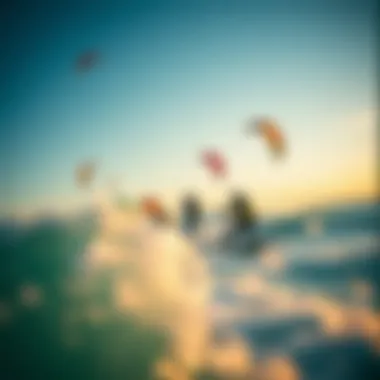
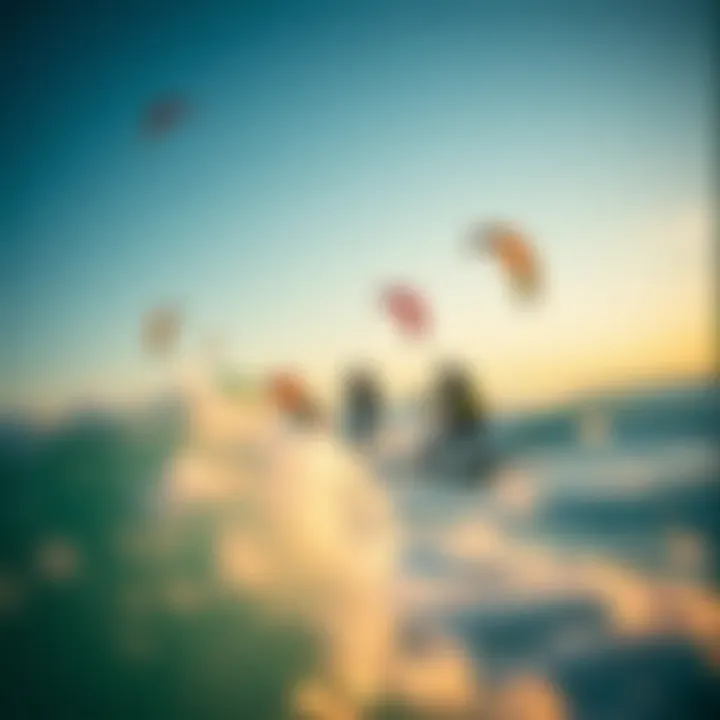
Types of Kite Sails
Understanding the different types of kite sails is crucial for anyone involved in kiteboarding. Each design serves a specific purpose, catering to various conditions and styles of riding. This segment explains the major categories of kite sails—Leading Edge Inflatable, Foil Kites, and Hybrid Kites. Mastery of these types not only influences performance but also enhances the overall experience on the water. Selecting the right kite sail based on these types can significantly impact your skills, safety, and enjoyment.
Leading Edge Inflatable (LEI) Kites
Leading Edge Inflatable kites, or LEIs, are among the most popular options in kiteboarding, especially for beginners and intermediate riders. The design features a rigid structure supported by inflated tubes running along the leading edge. This gives the sail its distinct shape and buoyancy.
One of the major benefits of LEI kites is their versatility. They can handle a range of wind conditions, providing a stable flying experience. This adaptability makes them a go-to choice for those who might hit varying conditions on the same day.
- Stability: The inflated leading edge allows for better control, especially when launching and landing.
- Durability: LEIs are built to withstand harsh conditions, which is important when you're out there getting tossed around by the wind.
- Easier Water Relaunch: If you ever crash in the water, LEIs are designed to be easily relaunched, minimizing the hassle.
However, LEIs do require a bit more gear—a pump for inflation and a good understanding of how to manage the inflated structure in the air.
Foil Kites
Foil kites represent a different approach to kite design, as they do not require inflatable structures to maintain shape. Instead, they rely on air flowing through cells or chambers to create lift. You'll often find these types of kites used in specific disciplines like snowkiting or landboarding.
The advantages of foil kites include:
- Lightweight Design: Without the need for inflation, foil kites are generally lighter, making them easier to transport.
- Efficiency: They can be aerodynamically more efficient, often providing more lift with less wind. This aspect can allow riders to take advantage of lighter wind conditions while still getting a good ride.
- Maneuverability: Foil kites offer precise control and responsiveness, which can greatly benefit experienced riders looking to perform tricks and jumps.
However, because of their design, foil kites can be more challenging for newcomers. Their water relaunch capabilities can also be a drawback since they may require more skill to manage after a drop.
Hybrid Kites
As the name suggests, hybrid kites blend features of both LEIs and foil kites, aiming to capitalize on the benefits of each design. They typically incorporate inflatable components along with airfoil shapes found in foils. This makes them quite versatile, appealing to a wide range of riders.
- All-Rounder: Hybrid kites are adaptable to various wind conditions and rider abilities, from the leisurely to the more aggressive.
- Performance: Riders often praise hybrids for their balanced performance, providing good lift and stability without the worries associated with either traditional LEIs or foils.
- Ease of Use: They tend to be more user-friendly, making them a solid option for those entering the sport or those aiming to refine their skills.
While hybrid kites offer a great blend of features, it's essential for every kiteboarder to evaluate their unique riding style and the specific conditions they typically face. This meticulous assessment will guide the optimal choice in kite sail type, turning gear into a precise extension of the rider's skill and style.
Selecting the Right Kite Sail
Choosing the right kite sail is akin to finding the perfect pair of shoes—it's all about comfort, fit, and functionality. An appropriate kite sail not only enhances your performance but also ensures safety on the water. The right sail allows for better control, responsiveness, and efficiency in various wind conditions. A mismatched sail can turn a fun day of kiteboarding into a frustrating experience, potentially leading to unsafe situations.
When tackling the question of which kite sail to opt for, several critical factors come into play. These are not mere suggestions but rather essential elements that every kiteboarder must weigh carefully to make an informed decision.
Factors to Consider
When selecting a kite sail, there are multiple factors to take into account:
- Skill Level: A beginner might benefit more from a stable, user-friendly kite sail, while advanced riders may prefer more agile and responsive designs.
- Wind Conditions: Understanding the typical wind patterns at your local spot is vital. Some sails perform better in lighter winds, while others excel on windy days.
- Riding Style: Freestyle, wave riding, or racing? Each discipline may require different kite characteristics.
- Weight and Build: Heavier or taller riders might need a different sail compared to lighter individuals.
It’s not just about picking the prettiest colors or the newest designs. Careful consideration of these factors can lead to a better experience on the water.
Size and Aspect Ratio
The size and aspect ratio of a kite sail can drastically influence its performance. The size of the sail typically determines the amount of lift it generates. A bigger kite will lift more, thus giving more power, which can be intoxicating for those looking to catch air. However, it also takes more finesse to control, especially in gusty conditions.
Aspect ratio—the relationship between the width and height of the kite—plays a crucial role too. A higher aspect ratio means a longer wingspan and typically results in better performance in higher winds, while maintaining speed through the air. Conversely, a lower aspect ratio offers more power and stability but might not glide smoothly through turbulent air.
Here's a quick breakdown:
- High Aspect Ratio: Better for speed and low drag; suited for tricks and racing.
- Low Aspect Ratio: More stability; best for beginners and unstable conditions.
In summary, the choice of size and aspect ratio should cohesively align with your experience, the usual wind conditions, and your personal kiteboarding ambitions. Every kite is a tool, and understanding how to wield that tool effectively is what separates good riders from great riders.
"Choosing the right sail is more than just picking a color. It's tailoring your gear to your unique needs and conditions."
For further reading, you may find valuable insights at Kiteboarding.com and Reddit's Kiteboarding Community. Also, exploring guidelines from International Kiteboarding Organization can lead you to significant resources on safety and style.
Understanding Wind Conditions
Understanding wind conditions is crucial for anyone involved in kiteboarding. It serves as the backbone of performance, safety, and enjoyment while navigating the water. The wind does not simply fill a kite; it dictates how one maneuvers across the waves, how high one can jump, and even the overall exhilaration of the ride. Therefore, having a good grasp of wind dynamics not only enhances one’s skills but also fosters a deeper respect for the natural environment.
Reading the Wind
Reading the wind involves more than just looking at the trees swaying or the ripples on the water. It is about interpreting subtle changes that can impact a kite's performance. Here are a few ways to effectively assess wind conditions:
- Be aware of wind direction: Wind typically comes from a prevailing direction. Knowing where the wind blows from allows kiteboarders to position themselves accordingly, maximizing their ride time.
- Observe wind speed: Understanding the strength of the wind is equally vital. Light winds may not support full kite control, while fierce gusts can lead to dangerous situations. A good kiteboarder keeps an eye on the feel of the wind on their skin and can tell when to launch or land.
- Look for telltale signs: Observing the surrounding environment such as flags, sailboats, and even the water texture can provide significant insights into wind behavior.
Importantly, each kite evolves differently based on wind strength and direction. Therefore, practicing reading the wind is a skill that requires time and effort.
"A good sailor is not one who can control the wind, but one who can adapt to it."
Effects of Wind on Performance
Wind does not just affect the kite; it influences the rider’s performance at every level. The responsiveness of the kite changes drastically with wind conditions:
- Underpowered Kites: If the wind is too light, a kite can feel sluggish. Riders might struggle to get enough power to lift off the water, resulting in a frustrating experience.
- Overpowered Kites: Conversely, strong winds can lead to a wild ride. An overpowered kite can tug the rider too violently, increasing the risk of losing control and accidents.
- Gusty Breeze: Wind gusts can cause erratic behavior in a kite. Riders must stay alert, as sudden bursts of wind can catch one off guard and lead to challenge in sustaining balance.
Being aware of how wind affects performance can help kiteboarders modify their approach, be it by changing speed, modifying technique, or selecting appropriate equipment for the conditions. Understanding these nuances ultimately leads to more successful and safe sessions on the water.
Advanced Kite Sail Techniques


Advanced kite sail techniques are essential for anyone serious about kiteboarding. These maneuvers unlock the full potential of both the kite and the rider, elevating the entire experience. When you get into the nitty-gritty of tuning and trick execution, you tap into a level of performance that can turn an average session into an unforgettable one. A kite's design and how it interacts with the wind are paramount, and mastering these techniques notably enhances control, navigation, and precision.
Tuning for Performance
Tuning your kite sail isn’t just a technical luxury; it’s a necessity. A well-tuned kite maximizes your efficiency while also ensuring your comfort. Adjusting various components like line length and bridle settings can drastically affect how the kite handles in different wind conditions.
- Line Length: Shortening or lengthening the lines affects responsiveness. Shorter lines provide a more aggressive feel, while longer lines allow for smoother rides, making it easier to manage gusts.
- Bridle Adjustments: Tweaking a kite's bridle can modify its angle of attack, thus affecting lift and stability. If the kite feels shaky, a simple adjustment might do the trick to improve performance.
- Inflation Pressure: The amount of air in your kite (for inflatable kites at least) is crucial. The correct pressure ensures that your kite retains its intended shape, allowing it to generate the right amount of lift.
More importantly, tuning for performance allows kiteboarders of all levels to tailor their gear to accommodate changing conditions. The right adjustments can make the difference between a frustrating outing and a day of seamless kiting. Moreover, not understanding the tuning aspects could lead to poor performance or even dangerous situations.
Jumping and Tricks
For many riders, jumps and tricks embody the thrill of kiteboarding. These maneuvers add excitement and showcase skills developed over time. However, executing them requires finesse.
- Jump Preparation: Timing is crucial. Begin with speed to gain momentum, then sheet in your sail. As you hit the wave or the right spot on the water, apply pressure to your back foot. This shifts your weight and sets you up for lift.
- Rotational Tricks: Incorporating spins or flips while airborne requires a solid grasp of control and understanding of body mechanics. Begin with simple 180-degree turns before branching into rotations. Each trick has its learning curve, and practice will pay dividends.
- Landing: Proper landing technique is often overlooked, yet it’s vital. Aim to land on the edge of the board to absorb the impact softly. This not only reduces the risk of injury but also keeps the momentum going, allowing you to transition smoothly into the next trick.
"Practicing tricks can feel daunting at first, but breaking them down into smaller, manageable steps makes all the difference. Remember, every expert was once a beginner."
Maintenance and Care for Kite Sails
Taking care of kite sails is not just a matter of prolonging their lifespan; it's about ensuring an optimal performance every time you hit the water. The care you give your sail can directly impact your safety and enjoyment while kiteboarding. A well-maintained kite sail allows for better handling, improved aerodynamics, and can withstand the wear and tear that comes with the sport. Understanding maintenance practices instills a sense of confidence, allowing you to focus more on riding and less on potential equipment failures. Hence, this section delves into critical aspects of maintaining your kite sails for peak performance.
Cleaning Protocols
Keeping your kite sails clean is essential but often overlooked. Saltwater, sand, and dirt can be quite harsh on the materials of your kite sail. Here’s a step-by-step guide for cleaning:
- Rinse with Fresh Water: After each session, give your kite a good rinse with freshwater. It helps remove salt, sand, and other debris that may have lodged into the fabric and seams.
- Use Mild Soap: If there's stubborn grime, mix a gentle soap with water. Using a soft sponge or cloth, gently scrub the affected areas. Avoid harsh detergents or brushes that can damage the fabric.
- Dry Thoroughly: Let your kite dry completely in a shaded area. Avoid direct sunlight as it can break down the materials over time. Make sure to turn it inside out to facilitate drying.
- Check for Damage: During cleaning, keep an eye out for any punctures or tears. Spot them early to avoid bigger problems down the line. A little maintenance can save you from losing a kite mid-ride, which nobody wants!
"Treat your gear well, and it will treat you well."
Following these protocols ensures that your kite sails maintain their performance and grab when you need them most.
Storage Tips
The way you store your kite can significantly affect its lifespan and overall integrity. Here are some best practices:
- Roll, Don’t Stuff: When packing away your kite, always roll it instead of stuffing it into a bag. Rolling avoids creases that can weaken the material over time.
- Choose a Cool, Dry Place: Store your kite in a cool, dry environment, away from direct sunlight. A temperature-controlled space is ideal, avoiding the potential pitfalls of moisture that might lead to mold or mildew.
- Keep It Out of Reach: If you’re storing your kit in a garage or outdoor shed, ensure it's stored high or in a secure bin. Animals or insects can ruin your gear if they decide to make a home out of it.
- Use Protective Bags: Consider investing in bags specifically designed for kite storage. These can provide an extra layer of protection against the elements and accidental tears or punctures.
By adhering to these guidelines, kiteboarders can significantly enhance the longevity and performance of their sails. Routine maintenance pays off in the long run, enabling riders to embrace the thrill of the sport without worries about their equipment. For more information on kite maintenance, you can explore resources like Wikipedia or Britannica.
Safety Considerations
Safety in kiteboarding is not just about following rules; it’s about recognizing the unpredictable nature of the sport and preparing accordingly. Considerations surrounding safety ensure that participants can enjoy their time on the water while minimizing risks. Understanding and implementing safety protocols can prevent accidents and injuries, making it crucial for both novice and experienced kiteboarders.
As kite sails interact intimately with wind and water, riders must be vigilant about both their equipment and their environment. Here’s where pre-ride checks and emergency handling come into play. Kiteboarding should be a source of enjoyment, and safety protocols lay the groundwork for that experience.
Pre-Ride Safety Checks
Before hitting the waves, it's wise to conduct a thorough pre-ride check of your equipment. Think of this as your kiteboarding ritual; it sets the tone for your ride and reassures you that you're prepared for what lies ahead. Consider the following components during your inspection:
- Kite Condition: Inspect for any tears, rips or punctures. Even the tiniest hole can lead to significant issues once the kite is airborne.
- Lines and Connections: Check that all lines are untangled and properly connected. Lines that are frayed or nicked should be replaced. A tangled or damaged line can severely impact your control.
- Harness and Safety Release: Ensure that your harness fits correctly and the safety release works flawlessly. Your harness is your lifeline, so it must be in top shape.
- Wind Conditions: Assess the wind speed and direction. This isn't just about your kite's performance; it's also about your skill level. Don’t bite off more than you can chew.
By doing this simple checklist, you essentially create peace of mind and can ride with more confidence. Remember, it’s like locking your door before leaving home—always a good idea.
Handling Emergencies
Even with the best preparations, emergencies can arise. Knowing how to handle critical situations can mean the difference between quick recovery and serious trouble on the water. Here are some scenarios to be prepared for:
- Kite Down: If your kite crashes or gets tangled, don’t panic. Control your descent by managing your body movements and looking out for others nearby. Prioritize safely retracting your lines and securing your kite.
- Equipment Malfunction: If your safety release or harness fails, maintain composure. Swim away from your kite to avoid dragging it in the water, while signaling for help. A calm approach ensures you're better able to navigate unexpected situations.
- Injury: In case of an injury—be it you or someone else—it’s crucial to know your first-aid procedure. Keep a basic first-aid kit nearby at the beach. Inform the right personnel immediately if the injury is severe.
When faced with emergencies, having a plan ensures you can respond quickly and effectively. Training sessions often cover these aspects as well, making practical knowledge vital in a sport that can swiftly change from tranquil beauty to turbulent chaos.
"In kiteboarding, safety is a journey, not a destination. Always be prepared, and respect the winds."
Whether it’s through scheduled safety checks or understanding emergency protocols, taking these precautions contributes to a safer kiteboarding experience. The thrill of riding the waves should always outweigh the concern of potential hazards, so equip yourself wisely.
Environmental Impact of Kiteboarding
Significance of Environmental Considerations in Kiteboarding
As the adrenaline-fueled sport of kiteboarding continues to grow in popularity, it becomes increasingly essential to address the environment impacts linked to it. Kiteboarding enthusiasts enjoy the thrill of gliding across the water, but this enjoyment shouldn't come at the expense of nature. Understanding the environmental footprint of kite sails and kiteboarding practices plays a vital role in promoting sustainable enjoyment of this sport. Clear awareness about such impacts enables riders to not only enjoy their time on the water but be responsible stewards of the environment.
Key Elements to Consider:
- Pollution from Materials: As kite sails are made from various fabrics and plastics, the production process can contribute to land and ocean pollution.
- Littering: Discarded kite gear and accessories can become marine debris, affecting wildlife and ecosystems.
- Eco-System Disturbance: Frequent kiteboarding in sensitive coastal areas can disturb local wildlife and habitats.
Eco-Friendly Practices
In an attempt to strike a balance between enjoying kiteboarding and protecting the environment, several eco-friendly practices can be implemented by riders.
- Choosing Sustainable Materials: Opting for kite sails made from recycled or eco-friendly materials helps minimize the impacts of production. Not only do brands such as Naish and Ozone incorporate such materials, but they also focus on sustainability in their overall production processes.
- Responsible Disposal: Instead of tossing old or damaged gear, kiteboarders should explore recycling programs or donate their equipment. This commitment can significantly reduce the amount of waste entering landfills.
- Adopting Clean-Up Initiatives: Participating in local clean-up events or organizing beach clean-ups helps keep waterways clear and reduces pollution from human activity.
- Following Guidelines: Respecting local regulations regarding wildlife and natural habitats ensures that kiteboarding is conducted in a responsible manner, preserving delicate ecosystems while enjoying time on the water.
- Educating Others: Sharing knowledge about eco-friendly practices with fellow riders encourages a community-focused effort towards environmental awareness.
Impact on Marine Life
The bond between kiteboarding and marine life is a complex one. On one hand, kiteboarding enthusiasts bask in the beauty of nature; on the other, careless practices can inadvertently harm marine ecosystems.
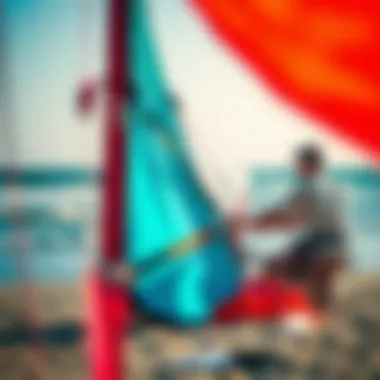
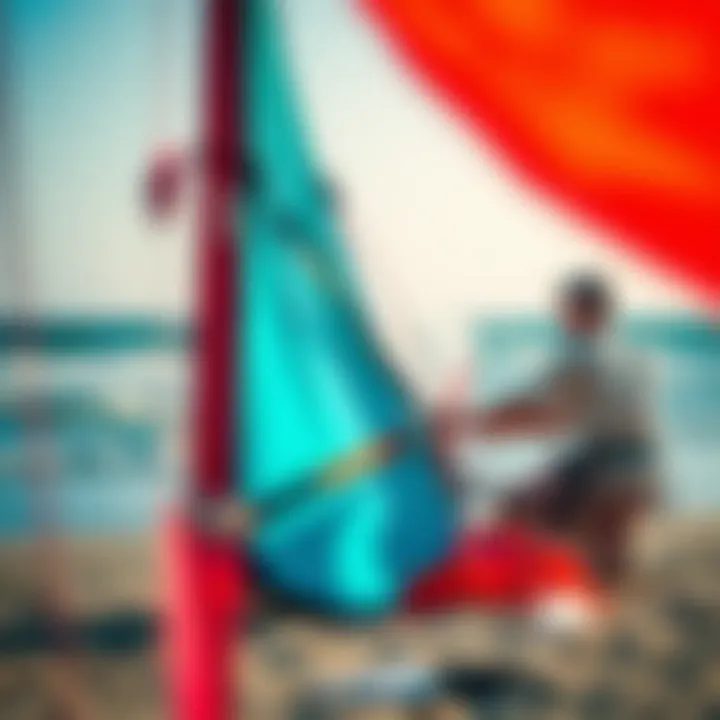
Understanding the Effects:
- Noise Pollution: The rush of wind and sound of kites in action can disturb marine mammals, leading them to veer away from their natural habitats.
- Physical Harm: Kites and lines can pose threats to fish and other marine creatures, especially if equipment is lost in the water.
- Habitat Interference: Kiteboarding can alter bird nesting sites and disrupt the natural behavior of coastal fauna through overexposure to foot traffic in sensitive areas.
In light of these impacts, it’s critical for kiteboarders to educate themselves about the local marine life and take active steps to minimize harm.
Solutions for Mitigating Impact:
- Avoiding Sensitive Areas: Knowledge of local wildlife and their breeding cycles is vital for choosing where to kiteboard.
- Respectful Riding: Keeping a safe distance from marine animals ensures that their habitats remain undisturbed. Avoiding actions that might scare or harm them is essential for a healthy marine balance.
Ultimately, awareness, education, and direct action toward eco-friendly practices in kiteboarding not only safeguard marine life but also enhance the overall kiteboarding experience. Harnessing the wind responsibly leads to a sustainable and spirited connection with the natural world.
Kite Sails in Competitive Events
In the realm of kiteboarding, competitions serve as a proving ground for both skill and technology. The role of kite sails in these competitive events is not merely functional; it can determine the difference between a podium finish and being an also-ran. This section dives into why kite sails take center stage during events, emphasizing regulations, standards, and notable competitions that shape the landscape of the sport.
Regulations and Standards
Competition kiteboarding isn't a free-for-all; it’s governed by a set of regulations that ensure fair gameplay and safety. Riders must adhere to standards laid down by organizations like the International Kiteboarding Association (IKA). Here are some critical regulations and their implications:
- Kite Size Measurement: Each kite used in competitions must meet specific size requirements based on the rider's weight and the wind conditions. This level of specification not only ensures fair competition but also caters to varying skill levels.
- Safety Features: Kites must include safety systems that enable riders to swiftly detach from the kite in case of emergencies. These could include quick-release mechanisms or leash systems, which have become non-negotiable in many events.
- Approved Materials: Only kites made from specified materials are allowed. Materials need to withstand not just the wear and tear of competitive use but also the environmental conditions they face.
Failure to follow these regulations can lead to disqualification, emphasizing the need for participants to stay informed about the latest guidelines.
Notable Competitions
Kiteboarding competitions are more than just a test of individual skill; they are celebrations of the sport, drawing enthusiasts and spectators from all around the globe. Some noteworthy events stand out, showcasing the top talents and the latest in kite sail technology:
- The Red Bull King of the Air: A pinnacle event where riders perform aerial acrobatics, showcasing their abilities in gusty conditions. The kite sails used here are specially designed for high performance, balancing lift and stability.
- Kite Foil Gold Cup: This competition emphasizes the fusion of kiteboarding and foiling. Here, the choice of kite sail is crucial. The lightweight and aerodynamic designs allow riders to skim smoothly across the water while maximizing speed and maneuverability.
- The GKA Kite World Tour: This tour features multiple events around the world, each showcasing various disciplines including freestyle and strapless freestyle. The diverse wind conditions prompt competitors to select kite sails that can adapt, making it a true testament to skill and technology intertwining.
Kite sails are not mere fabric in the wind; they are engineered tools essential to the sport's competitive sphere, influencing performance and safety alike.
"In the world of kiteboarding, the kite sail is the dancer and the wind is the music. Understanding how to move in sync is what takes you from good to great."
In summation, kite sails in competitive events are integral not just for performance but also for adhering to regulations that promote safety and fairness. As technology continues to evolve and events gain international prestige, understanding how these sails impact the sport remains essential for any serious kiteboarder.
Future of Kite Sail Technology
The kiteboarding community stands on the brink of a technological revolution, particularly in the realm of kite sails. Advances in materials science, design engineering, and environmental consciousness are driving this evolution. Understanding these changes is essential for any kiteboarder who aims to stay at the forefront of the sport. The future of kite sail technology isn't just about pushing the envelope; it's about enhancing performance, safety, and sustainability, ensuring that riders can enjoy the sport for years to come.
Innovations in Design
The design of kite sails has come a long way from the early days of kiteboarding. Today, cutting-edge innovations are shaping how these sails interact with the wind and water, leading to a more dynamic and responsive riding experience. For instance, the integration of computational fluid dynamics in the design process allows engineers to simulate how sails will perform in various wind conditions.
Some specific innovations include the following:
- Shape Memory Materials: Materials that can change shape and return to their original form help create sails that adjust to wind conditions for enhanced performance.
- Multiple Profiles: Modern kites can feature different profiles within the same sail, optimizing performance for different maneuvers, be it soaring through the sky or cutting through waves.
- Customizable Construction: With advanced manufacturing techniques, riders can now customize their kites more easily than ever before, allowing for a personal touch in terms of performance and aesthetic.
The benefits of these innovations extend beyond just performance:
- Increased durability against wear and tear, ensuring that sails last longer in rough conditions.
- Improved handling that allows less experienced riders to feel more confident on the water.
As the design progresses, kite sails are beginning to resemble finely tuned racing machines rather than mere pieces of fabric caught in the wind.
Sustainability Trends
As with many other aspects of our lives, sustainability is becoming increasingly important in kite sail technology. The kiteboarding community has begun to embrace eco-friendly practices in sail production and use, recognizing that protecting the environment is as vital as advancing performance.
Several noteworthy sustainability trends in kite sail technology include:
- Recyclable Materials: Many producers are now using plastics made from recycled materials, which cuts down reliance on new resources and minimizes waste.
- Biodegradable Fabrics: Ongoing research in materials science is paving the way for fabrics that break down naturally, thus reducing environmental impact.
- Manufacturing Processes: Companies are adopting low-waste techniques in their production lines, helping to ensure fewer resources are wasted during the creation of kite sails.
The environmental aspect of sail technology not only contributes to the well-being of the planet but also sets a standard for future sports equipment. As more kiteboarders prioritize eco-friendly practices, the overall sustainability of the sport improves.
In summary, kite sail technology is moving forward with innovations that enhance performance and contribute positively to the environment. Embracing these changes is not merely a choice but a necessity for anyone passionate about kiteboarding. It's about riding the wind not just for thrills, but for a sustainable future.
"The future belongs to those who believe in the beauty of their dreams." - Eleanor Roosevelt
Through these advancements, kiteboarding is poised to become not just a sport but a safe, sustainable experience that connects enthusiasts with nature. For a deeper understanding and further reading, check out resources on Sustainable Kiteboarding Practices and Innovative Kite Technologies.
For additional industry insights and updates, please visit organizations like the International Kiteboarding Association or engage with local kiteboarding communities on platforms such as Facebook.
Engaging with these communities will not only enhance your knowledge but foster meaningful conversations about the future of our beloved sport.
The End
As we draw the curtain on our exploration of kite sails, we stand at a crossroads where the worlds of technology and nature meet. Kite sails are not just the colorful fabric that glides above our heads; they represent the intricate balance of design, performance, and safety that forms the backbone of kiteboarding. Understanding the mechanics of these sails is paramount not only for seasoned riders but also for those just starting out. Each component, from the materials chosen to the specific types of kites, plays a crucial role in how a kite interacts with wind and water.
In this article, we've delved into several key elements that truly resonate within the kiteboarding community. The selection of the right kite sail can make or break a riding experience. Matching the sail with wind conditions is fundamental; it dictates not only performance but also safety. By prioritizing proper maintenance, caring for your gear, and staying attuned to the environment, kiteboarders can enjoy their time on the water while minimizing harm to the marine ecosystems.
Furthermore, the insights shared about innovations in kite sail technology remind us that this sport is ever-evolving. The future holds promise with developments aimed at enhancing sustainability, which is increasingly important in our world today. As enthusiasts, it is our responsibility to adapt and advocate for eco-friendly practices, ensuring that future generations can experience the thrill of kiteboarding.
In essence, kite sails symbolize the dance between rider and nature, a relationship that should be nurtured with respect and knowledge.
Recap of Key Points
- Kite Sail Anatomy: Understanding their components and materials helps in selecting the appropriate gear.
- Type Selection: Different kites, like LEI, foil, and hybrids, serve various riding styles and conditions.
- Wind Dynamics: Properly reading wind conditions can enhance performance and safety.
- Maintenance: Following proper cleaning and storage protocols keeps sails in top condition.
- Safety: Conducting pre-ride checks and knowing how to handle emergencies significantly boosts rider safety.
- Environmental Considerations: Embracing sustainable practices ensures we can enjoy kiteboarding for years to come.
- Technological Advances: Innovations promise to change the way we experience our beloved sport.
Encouragement for Continued Exploration
As you paddle away from this article and step out into the wild blue yonder, remember that the relationship with your kite is an ongoing journey. Don’t shy away from asking questions, experiencing different types of sails, and honing your skills. Each outing can teach you something new about kites, the wind, and maybe even yourself. Whether you’re a novice taking your first flight into the sky or a seasoned rider mastering aerial tricks, continuous learning is what keeps the spirit of kiteboarding alive. Exploring different conditions, participating in community events, and experimenting with your gear can be both rewarding and enlightening. So go ahead, make your mark with every gust of wind, and let the kite sails be your guide, propelling you into adventures yet to unfold.




